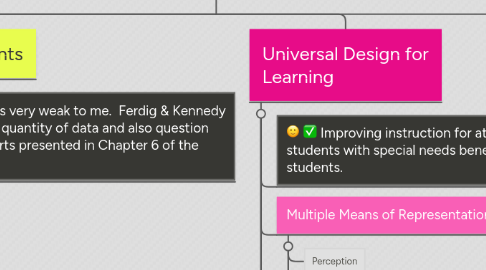
1. Special Education Students
1.1. This research base seems very weak to me. Ferdig & Kennedy suggest increased quality and quantity of data and also question the caliber of the written reports presented in Chapter 6 of the online text.
1.2. Curriculum Evaluation
1.2.1. Should benefit all learners
1.2.2. Focus on improvement (pretest to postest) for all students
1.3. Student Achievement
1.3.1. Students' approach to online learning is the same
1.3.2. Student achievement for special education students is NOT the same as that of other students. (It's worse.)
1.4. Stakeholder Perceptions
1.4.1. Grades for online special education students are not significantly different than in F2F classrooms.
1.4.2. Parents and students in the online realm are more educated about their disabilities.
1.4.3. Online environment empowers students by reducing stigma of disability.
1.4.4. Communication with online teachers is greatly appreciated.
1.5. Policy Structures
1.5.1. Very little research here (1 study).
1.5.2. Varies widely state to state.
1.6. Policy Considerations
1.6.1. 1. Access to technology.
1.6.2. 2. Implement challenging + effective practices for online instruction.
1.6.3. 3. Require all accommodations/modifications necessary or possible.
1.7. Practice Suggestions
1.7.1. Online Strategy Instruction
1.7.1.1. Choose and use SIMPLE tools!
1.7.2. Academic Performance
1.7.2.1. Maximize student-teacher interaction and the support provided by the teacher in order to maximize student success.
1.7.3. Content-Based e-Learning
1.7.3.1. Honors students still excel the most and benefit the most from the technology.
1.7.4. Information Technology & Transition Skills
1.7.4.1. Build interdisciplinary skills and social skills in addition to content knowledge.
1.7.5. Social Competence Intervention
1.7.5.1. Use virtual worlds to provide scaffolding for Social Skills classes (for instance for students with Autism).
2. Universal Design for Learning
2.1. Improving instruction for at-risk students and students with special needs benefits ALL students.
2.2. Multiple Means of Representation
2.2.1. Perception
2.2.1.1. Display, Auditory, Visual
2.2.2. Language, Math, Symbols
2.2.2.1. Clarify, teach, use multiple media to represent
2.2.3. Comprehension
2.2.3.1. Prior knowledge, patterns, features, ideas, relationships
2.3. Multiple Means of Action & Expression
2.3.1. Physical Expression
2.3.2. Expression & Communication
2.3.3. Executive Function
2.3.3.1. Goal setting, planning, managing resources, monitoring progress
2.4. Multiple Means of Engagement
2.4.1. Interest
2.4.2. Effort & Persistence
2.4.3. Self-regulation
2.5. Design Aspects to Consider:
2.5.1. 1. Goals
2.5.2. 2. Materials
2.5.3. 3. Methods
2.5.4. 4. Assessment
3. At-Risk Students
3.1. The Coy article emphasizes the importance of a Learning Coach (and team) at home. That seems to contradict the idea that at-risk students would thrive in a virtual environment.
3.2. Four Factors
3.2.1. School
3.2.2. Student
3.2.3. Community
3.2.4. Family
3.3. Online Benefits
3.3.1. Flexible Scheduling
3.3.2. Individual Mentoring
3.3.3. Safe Communities
3.3.4. Varied Methods of Teaching
3.4. Policy Suggestions
3.4.1. Expand iNACOL Standards to include at-risk and special education students
3.4.2. Support/mandate evidence-based practices
3.5. Practice Suggestions: The 5Cs
3.5.1. Curriculum
3.5.1.1. Based on student needs + interests
3.5.1.2. Increase time on task
3.5.2. Caring Community
3.5.2.1. Acknowledge + value everyone
3.5.2.2. Collaboration between parents, teachers, school personnel
3.5.3. Control
3.5.3.1. Academic, Social, Behavioral
3.5.3.2. Decision making, problem-solving, goal setting, observing and evaluating
3.5.4. Climate
3.5.4.1. Positive
3.5.4.2. High expectations
3.5.4.3. Opportunities to succeed
3.5.5. Connect
3.6. Additional Practice Suggestions
3.6.1. Teacher prep programs must change and improve.
3.6.2. Professional development must help teachers understand, identify, and differentiate.
3.6.3. Program and course design must be accessible and supportive for students.
3.7. Future Research
3.7.1. Case studies: students + teachers
3.7.2. Longitudinal studies: student outcomes + post-school goals
3.7.3. Incorporate 5Cs Framework
